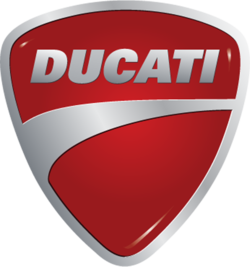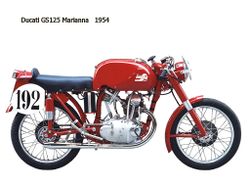Ducati History
Ducati was founded in 1926 by Adriano and Marcello Ducati. They founded the company in Bologna to produce electrical components. After the second world war, the factory was left badly damaged and was taken over by the government in exchange for their investment.
Ducati, looking for new opportunities began producing the Cucciolo in 1946, which was a 50cc four-stroke that clipped onto a bicycle frame. The Cucciolo was a huge success and in 1954 the firm appointed Fabio Taglioni as it's new chief designer.
History[edit | edit source]
From their first post-Second World War bicycle-like low-displacement motorbikes Ducati has gained prominence in motorcycle racing and in the motorcycle industry.
When Ducati began manufacturing motorcycles, they were single cylinder engines. Ducati produced single cylinder motorcycles from 1950 to 1974. Chief Engineer Fabio Taglioni developed a desmodromic valve system in these years, a system that opens and closes the valves using the camshaft, without the need for valve springs. This valve system has become a trademark feature of Ducati motorcycles.
In the 1960s, Ducati earned its place in motorcycling history by producing the then fastest 250cc road bike available, the Mach 1.In the 1970s Ducati began producing large-displacement L-twin (i.e. a 90° V-twin) motorcycles and in 1973 released an L-twin with the trademarked desmodromic valve design. In 1985, Cagiva bought Ducati and planned to rebadge Ducati motorcycles with the lesser-known Cagiva name (at least outside of Italy). By the time the purchase was completed, Cagiva kept the "Ducati" name on its motorcycles. In 1996, Texas Pacific Group bought for US$325 million a 51% stake in the company and in 1998, bought the remaining 49% and became the sole owner of Ducati. In 1999, TPG issued an IPO of Ducati stock and renamed the company Ducati Motor Holding SpA. TPG sold over 65% of its shares in Ducati. In December 2005 Ducati returned to Italian ownership with the sale of Texas Pacific's stake (minus one share) to Investindustrial Holdings, the investment fund of Carlo and Andrea Bonomi.
Ducati Company history[edit | edit source]
In 1926, three brothers Adriano, Marcello and Bruno Ducati founded Societa Scientifica Radio Brevetti Ducati in Bologna. The company produced tubes, condensers and other radio components. The cornerstone of a new factory in Borgo Panigale was laid in 1935. During the war, the factory was a target for Allied bombing. Although badly hit more than once, production was maintained. About this time Aldo Farinelli began working with the small Turinese firm SIATA (Societa Italiana per Applicazioni Tecniche Auto-Aviatorie) with the idea of developing a small engine that could be mounted on a bicycle. The noise of the engine's short stubby exhaust inspired the name "Cucciolo" (Italian: "little puppy"). Barely one month after the official liberation of Italy, SIATA announced their intention to sell Cucciolo engines to the public; it was the first new automotive design to appear in postwar Europe. The first Cucciolos were available only as a motor to be attached by the owner to a normal bicycle. Some businessmen bought the little engines in quantity, installed them in frames and offered these complete units for sale.
By 1950, with 200,000 Cucciolos already sold, Ducati finally offered its own complete motorcycle based on the successful little pushrod engine. The collaboration with SIATA resulted in a well designed little 60 cc bike. This first Ducati motorcycle weighed 98 pounds and had a top speed of 40 mph (64 km/h). Its 15 mm carburetor gave a little under 200 mpg. In the 1950s, Ducati officially dropped the "Cucciolo" name, replacing it with "55M" or "65TL".
The market was moving towards bigger motorcycles though, and Ducati's IRI management felt diversification was the only answer. Ducati made an impression at the early 1952 Milan Show, introducing the Ducati 65 TS cycle and the Cruiser, a four-stroke motor scooter. Despite being described as the most interesting new machine at the 1952 show, the Cruiser was not a great success. A couple thousand were made over a two year period before being withdrawn from production.
In 1953, management decided to split the operation into two separate entities, Ducati Meccanica SpA, and Ducati Elettronica, under separate management. (Ducati Elettronica became Ducati Energia SpA in the eighties.)
Dr. Giuseppe Montano took over as head of Ducati Meccanica SpA and the old Borgo Panigale factory was modernized with government assistance. By 1954, Ducati Meccanica SpA was producing 120 bikes a day, but cheap cars were entering the market, and sales for many motorcycle manufacturers would decline.
From the 1960s to the 1990s the Spanish company MotoTrans licensed Ducati engines and produced motorcycles that were recognizably Ducati derived, although incorporating many subtle differences. MotoTrans' most notable machine was the 250 cc 24 Horas (Spanish: 24 hours), a 285cc version that won the Barcelona twenty-four hour race at the Montjuic circuit for three consecutive years, 1956 to 1958.
Ducati Motorcycle designs[edit | edit source]
Ducati is best known for high performance motorcycles characterized by large capacity four-stroke, 90-degree L-twin engines featuring a desmodromic valve design. Modern Ducati’s remain among the dominant performance motorcycles available today partly because of the Desmodromic valve design, which is nearing its 50th year of use. Desmodromic valves are closed with a separate, dedicated cam lobe and lifter instead of the conventional valve springs used in most internal combustion engines. This allows the cams to have a more radical profile, thus opening and closing the valves more quickly without the risk of valve-float which is likely when using a "passive" closing mechanisms under the same conditions.
While most other manufacturers utilize wet-clutches (with the spinning parts bathed in oil) Ducati uses multiplate dry clutches in many of their current motorcycles. The dry clutch eliminates the power loss from oil viscosity drag on the engine even though the engagement may not be as smooth as the oil bath versions, and the clutch plates can wear more rapidly.
Ducati Product history[edit | edit source]
The chief designer of Ducati motorcycles from the 1950s was the late Fabio Taglioni (1920-2001). He designed most Ducati’s during this period, ranging from the small single cylinder machines that were successful in the Italian 'street races' up to the large capacity twins of the 80s. Ducati introduced the Pantah in 1979; its engine was updated in the 1990s in the Ducati SuperSport (SS) series. All modern Ducati engines are derivatives of the Pantah, which uses a toothed belt to actuate the engine's valves. Taglioni used the Cavallino Rampante (identified with the Ferrari brand) on his Ducati motorbikes, Taglioni chose this emblem of courage and daring as a sign of respect and admiration for Francesco Baracca, a heroic World War I fighter pilot that died during an air raid in 1918.
1970s[edit | edit source]
In 1973, Ducati also commemorated its 1972 win at the Imola 200 with the production model green frame Ducati 750 SuperSport.
(In 2006 the retro styled Ducati PaulSmart1000LE, which shares styling cues with the 1973 750 SuperSport (itself a production replica of Paul Smart's 1972 race winning 750 Imola Desmo) was released, as one of a SportClassic series representing the 750 GT, 750 Sport, and 750 SuperSport Ducati motorcycles.)
1980s[edit | edit source]
Ducati's liquid-cooled multi-valve V twins made from 1985 on are known as Quattrovalvole ("four-valve"). These include the 916 and 996, 999 and a few predecessors and derivatives.
1990s[edit | edit source]
In 1993, Miguel Angel Galuzzi introduced the Ducati Monster, a naked bike with exposed trellis and engine. Today the Monster accounts for almost half of the company's worldwide sales. The Monster, which has been out since 1994, has undergone the most changes of any motorcycle that Ducati has ever produced. After more than a decade of manufacturing, Ducati continues to create innovative changes to this classic motorcycle.
In 1993 , Pierre Terblanche , Massimo Bordi and Claudio Domenicali designed the Ducati Supermono . A 550cc single cylinder light weight Catalog Racer. Only 67 were built between 1993-1997.
In 1995, the company introduced the Ducati 916 model designed by Massimo Tamburini, a water-cooled version that allowed for higher output levels and a striking new bodywork that featured aggressive lines, underseat exhausts, and a single-sided swingarm. Ducati has since ceased production of what many called the bike of the 1990s, supplanting it with the 749 and 999.
Motorcycle design history[edit | edit source]
Ducati (in its various incarnations) has produced several styles of motorcycle engines, including varying the number of cylinders, type of valve actuation and fuel delivery. Ducati is best known for its "L-Twin" motor which is the power plant in the majority of Ducati-marqued motorcycles. Ducati has also manufactured engines with one, two, three or four cylinders; operated by pull rod valves and push rod valves; single, double and triple overhead camshafts; two stroke and even at one stage manufactured a stationary diesel engine, many of which were used as emergency pumps (e.g for fire fighting). Currently, Ducati makes no other engines except for its motorcycles.
On current Ducati motors except for the Desmosedici, the valves are actuated by a standard valve cam shaft which is rotated by a timing belt driven by the motor directly. The teeth on the belt keep the camshaft drive pulleys indexed. On older Ducati motors, prior to 1981, drive was by solid shaft that transferred to the camshaft through bevel-cut gears. This method of valve actuation was used on many of Ducati's older single cylinder motorcycles - the shaft tube is visible on the outside of the cylinder.
Ducati is also famous for using the desmodromic valve system championed by engineer and designer Fabio Taglioni though they have also used engines that use valve springs to close their valves. In the early days, Ducati reserved the desmodromic valve heads for its higher performance bikes and its race bikes. These valves do not suffer from valve float at high engine speeds, thus a desmodromic engine is capable of far higher revolutions than a similarly configured engine with traditional spring-valve heads.
In the 1960s and '70s Ducati produced a wide range of small two-stroke bikes, mainly sub-100cc capacities. Large quantities of some models were exported to the U.S.

